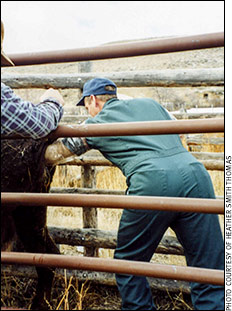When to Assist
Tips for when and how to check a cow that is calving.
Most cows and heifers progress normally through the stages of labor. Sometimes, however, the calf does not start into the birth canal and the cow does not begin hard straining. Knowing when to check a cow is crucial — and you have to be watching her to know how long she’s been in early labor.
Mark Hilton, Purdue University veterinarian, says a good rule of thumb is to look for progress every hour.

“If we don’t see progress in an older cow, there’s a problem,” Hilton says, noting the calf’s head or a leg may be turned back, the calf may be coming backward or breech, or some other situation may be preventing it from coming into or progressing through the birth canal. “In heifers, lack of progress is usually due to the calf being too big.”
If a cow that normally doesn’t spend much time in early labor (or delivers her calf quickly once she starts active labor) is taking longer than usual, check her, he suggests. It helps to know each cow’s individual behavior and history.
“I had a cow that would always separate herself from the herd 24-36 hours before she would calve, and that was normal for her,” Hilton says. All cows have their own patterns.
When you realize a cow needs to be checked, restrain her and clean her.
“Wash the vulva, use a clean OB (obstetrical) sleeve and apply lubrication,” Hilton says. “There are two possible scenarios when you reach into the birth canal. Either you’ll be able to figure out what you are feeling, or you aren’t sure what’s going on — and you’ll call your veterinarian for assistance.”
If you know what you are feeling, you have two options, he observes:
- 1. If you think you can correct the problem, deliver the calf.
- 2. If you think you need help, call your veterinarian. The calf might be breech (backward, with just the rump trying to come into the birth canal), it might be twins, or you may be dealing with a uterine torsion.
“Even as a veterinarian I have made mistakes and pulled calves I should have delivered by C-section, and this is hard on the cow and the calf — and sometimes results in a dead calf,” Hilton says. “You think the calf is not that big and start pulling, and get it halfway out and the hips are gigantic and you are in trouble.”
If the calf’s head is already out and its shoulders are close to coming through the pelvis, it can probably be pulled, Hilton observes. “If I reach my hand in and there’s no space between the calf’s shoulders and the cow’s pelvis, I am probably not going to get that calf through. The shoulders are usually smaller than the hips, so if the shoulders can’t make it, you know the hips won’t. It’s time to stop pulling before we get too far to push the calf back in and do a C-section. If I get the calf halfway out and he’s stuck, now I no longer have the option to do a C-section, and there’s no choice but to sacrifice the calf.”
If you can’t get your fingers over the calf’s forehead as the head starts through the pelvis — no room between the pelvis and the calf’s head — push it back into the uterus and call your veterinarian.
“The head is significantly smaller than the shoulders, and if the head isn’t going to fit through easily, it’s time to get help. We don’t like getting calls when people have a calf halfway out, and it’s already too late to save the calf. We want to give the calf every chance to be born alive,” Hilton says.

Editor’s Note: Heather Smith Thomas is a freelancer and cattlewoman from Salmon, Idaho.






